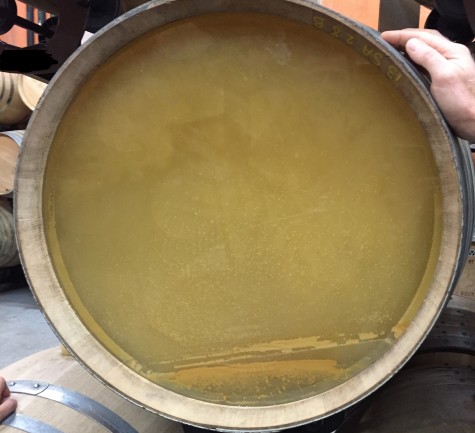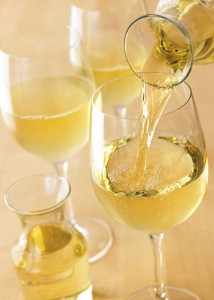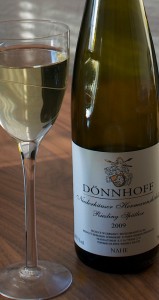
At the Chardonnay Symposium in May 2015, I heard a panel speak on the topic “To Oak or Not Oak.” The panelists included Christian Roguenant (CA winemaker raised in Burgundy), Dieter Cronje (CA winemaker raised in S. Africa), Karl Wente (CA winemaker and 5th generation winey owner) and Peter Molnar (partner in CA winery, Hungarian cooperage and GM of two CA vineyards).
 We tasted a Chardonnay from each winemaker made within the typical range of possibilities: with/without barrel fermentation, percentage of new oak (as little as none), time aged in barrel, with/without malolactic fermentation, with/without battonage. But what really caught my attention was the near unanimous conclusion that a richer, riper, more fruit-forward Chardonnay should be aged with a higher percentage of new oak barrels.
We tasted a Chardonnay from each winemaker made within the typical range of possibilities: with/without barrel fermentation, percentage of new oak (as little as none), time aged in barrel, with/without malolactic fermentation, with/without battonage. But what really caught my attention was the near unanimous conclusion that a richer, riper, more fruit-forward Chardonnay should be aged with a higher percentage of new oak barrels.
Only one panelist, Peter Molnar, said he would put more new oak on a leaner Chardonnay and less on a heavier Chardonnay. I agree with Peter but am curious why all the others thought the opposite. It’s been my experience that a Chardonnay that’s been picked at a lower brix level and has higher acidity can handle more new oak without the oak appearing too obvious. The wine can still seem balanced when it has 40% – 50% (sometimes more) new oak, and/or heavy toast.
Perhaps this difference in opinion has more to do with the winemaking style than how much oak the wine can absorb while remaining in balance. It’s true that the richness and weight of a Chardonnay is enhanced when new oak is added. If the style is intended to be “big,” the grapes are picked later, the acidity is lower, the alcohol is higher – and usually in line with this, the wine is toasty, sometimes buttery and perhaps a little sweet. Wine drinkers who like this style of wine expect all of these things, including the taste of new oak.
On the other hand, if someone likes a different style of Chardonnay – leaner, lower alcohol, more acidity, fresh and lively rather than rich, citrusy rather than tropical – the taste of new oak is often not appealing. But tasting the oak is different than the oak having influence. New oak can make a Chardonnay more complex, add weight and soften the acid bite (if no malolactic fermentation), yet still not taste “oaky.”
 The relationship between acidity and oak seems to be an important one and can perhaps be compared to that of acidity and sugar in German Riesling. Riesling from a cold climate like Germany’s can have 30+ grams/liter of residual sugar and not seem sweet. The acidity in these wines is so high that it counteracts the sweetness. If a Riesling made in California had as much residual sugar as a German spätlese, it would taste sweet and sappy. In some regions, if a wine is too acidic, a winemaker might actually add sugar (for lower quality wines) or leave residual sugar in the wine to make the wine more palatable.
The relationship between acidity and oak seems to be an important one and can perhaps be compared to that of acidity and sugar in German Riesling. Riesling from a cold climate like Germany’s can have 30+ grams/liter of residual sugar and not seem sweet. The acidity in these wines is so high that it counteracts the sweetness. If a Riesling made in California had as much residual sugar as a German spätlese, it would taste sweet and sappy. In some regions, if a wine is too acidic, a winemaker might actually add sugar (for lower quality wines) or leave residual sugar in the wine to make the wine more palatable.
Similarly with barrels, if wine has a good amount of acidity, it seems to balance out nicely with a good dose of toasty oak. Look at Burgundy. In this region, the acidity is usually higher (and alcohol lower) than in a lot of California wines. Some Burgundy producers use a lot of oak in their Chardonnays, and often with heavy toast, but it’s rarely obvious in the wine. And with time in bottle, these toasty flavors and aromas integrate even more, and the wine becomes incredibly complex and balanced.
The other factor in how much a wine (Chardonnay or otherwise) can handle new oak is the alcohol level. A higher alcohol wine will extract more of the toast flavors and aromas than a lower alcohol wine. So you can put more new oak on a lower alcohol wine and get more of the oak benefits (complexity/layers, weight, texture, ability to age) without overwhelming the wine with obvious oak flavors.
 Santa Maria Valley winemaker, Jim Clendenon of Au Bon Climat, ages his Chardonnay in up to 100% new oak for 18 to 24 months. His Chardonnays usually have an alcohol leave of around 13.5 % with a low pH. Jim’s wines are known for their aging potential, complexity and balance. It’s true that when some of his Chardonnays are young, the new oak can seem obvious, but let the wine breath in the glass for a bit, or better yet, let it age in bottle for a couple of years, and the oak becomes well integrated. It’s in perfect harmony with the rest of the wine.
Santa Maria Valley winemaker, Jim Clendenon of Au Bon Climat, ages his Chardonnay in up to 100% new oak for 18 to 24 months. His Chardonnays usually have an alcohol leave of around 13.5 % with a low pH. Jim’s wines are known for their aging potential, complexity and balance. It’s true that when some of his Chardonnays are young, the new oak can seem obvious, but let the wine breath in the glass for a bit, or better yet, let it age in bottle for a couple of years, and the oak becomes well integrated. It’s in perfect harmony with the rest of the wine.
I suppose this could be a reason some winemakers choose not to add a lot of oak to a leaner wine. Depending on the vintage, the wine might need to age longer in bottle (or barrel) in order to achieve optimal integration.
I want to clarify that I do not believe that all leaner Chardonnays can stand up to a lot of new oak. A wine that’s light in body and low in acidity might not be able to stand up to the oak, nor might a wine with high acidity but not a lot of fruit. Not only does the wine need a good amount of acidity but also fruit.
The winemaker’s ability to achieve balance is always one of the biggest challenges. And variables change every year based on what happens in the vineyard. We might all agree that the best wines have all attributes in balance: alcohol, acidity, sweetness, fruit, oak, tannin. But a style preference could lead a winemaker to put more weight on one or more of these variables.
How much new oak do you like to use on Chardonnay? And what are your stylistic goals? Please share comments below.

i like to oak it just enough